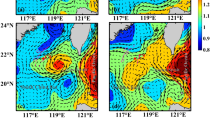Abstract
Observations of tidal waves between the East and South China Seas (ECS and SCS) over the Taiwan Strait (TS) suggest that the diurnal tides simply appear as one southward-propagating wave from the ECS to the SCS through the TS. The semidiurnal tides, however, behave differently in that they appear as a southward-propagating Kelvin wave in the western TS and a nearly standing wave in the eastern TS, and then diminish rapidly over the shallow shoal in the southern TS. A smaller-domain model, with sea-level boundary conditions derived from a larger-domain tidal model, was first used to simulate tides in the TS to an overall percentage of accuracy of about 90%. Subsequent numerical experiments and theoretical analysis revealed that the southward-propagating semidiurnal tides to be impeded and then reflected as they arrive at an abrupt, deepened step in the topography of the southern TS. This reflection enhances the amplitudes of the incident semidiurnal tides and contributes to the formation of a nearly standing wave in the eastern TS. The southward-propagating diurnal tides in the TS are connected by the diurnal tides in the northern SCS when the amplitudes of the two tide systems are comparable and their phases nearly equal at the step.
Similar content being viewed by others
References
Blumberg, A. F. and G. L. Mellor (1987): A description of a three-dimensional coastal ocean circulation model. p. 1–16. In Three-Dimensional Coastal Ocean Models, ed. by N. S. Heaps, American Geophysical Union.
Chao, S.-Y. and T. Paluszkiewicz (1991): The hydraulics of density currents over estuarine sills. J. Geophys. Res., 96, 7065–7076.
Dean, R. G. and R. A. Dalrymple (1991): Reflection and transmission past an abrupt transition. p. 141–144. In Water Wave Mechanics for Engineers and Scientists, Section 5.5, World Scientific Publishing Co. Pte. Ltd., Singapore, 353 pp.
Eanes, R. J. and S. V. Bettadpur (1996): The CSR 3.0 global ocean tide model. Center for Space Research, University of Texas, Austin.
Fang, G., Y.-K. Kwok, K. Yu and Y. Zhu (1999): Numerical simulation of principal tidal constituents in the South China Sea, Gulf of Tonkin and Gulf of Thailand. Cont. Shelf Res., 19, 845–869.
Greatbatch, R. J. and T. Otterson (1991): On the formulation of open boundary conditions at the mouth of a bay. J. Geophys. Res., 96, C10, 18431–18445.
Guo, X. and T. Yanagi (1998): Three-dimensional structure of tidal current in the East China Sea and the Yellow Sea. J. Oceanogr., 54, 651–668.
Hendershott, M. C. and A. Speranza (1971): Co-oscillating tides in long, narrow bays; the Taylor problem revisited. Deep-Sea Res., 18, 959–980.
Hilaly, N. (1969): Water waves over a rectangular channel through a reef. Journal of Waterways Harbors Division, American Society of Civil Engineering, 95, WW1, 77–94.
Hwung, H.-H., C.-L. Tsai and C.-C. Wu (1986): Studies on the correlation of tidal elevation changes along the western coastline of Taiwan. p. 293–305. In Coastal Engineering-1986, Taipei, Taiwan.
Hydrographer of the Navy (1993): Admiralty tide tables and tidal stream tables/Pacific Ocean and adjacent seas. Hydrographic Office, London, England.
Kang, S.-K., S.-R. Lee and H.-J. Lie (1998): Fine grid tidal modeling of the Yellow and East China Seas. Cont. Shelf Res., 18, 739–772.
Kantha, L. H. (1995): Barotropic tides in the global oceans from a nonlinear tidal model assimilating altimetric tides. Part I: Model description and results. J. Geophys. Res., 100, 25283–25308.
Lefevre, F., C. Le Provost and F. H. Lyard (2000): How can we improve a global ocean tide model at a regional scale? A test on the Yellow Sea and the East China Sea. J. Geophys. Res., 105, C4, 8707–8725.
Lin, M.-C., W.-J. Juang and T.-K. Tsay (2000): Application of the mild-slope equation to tidal computations in the Taiwan Strait. J. Oceanogr., 56, 625–642.
Liu, C.-S., S.-Y. Liu, S. E. Lallemand, N. Lundberg and D. L. Reed (1998): Digital elevation model offshore Taiwan and its tectonic implications. Terr., Atmos. Ocean. Sci., 9, 4, 705–738.
Ogura, S. (1933): The tides in the sea adjacent to Japan. Bulletin of the Hydrographic Department, Imperial Japanese Navy, 7, 1–189.
Orlanski, I. (1976): A simple boundary condition for unbounded hyperbolic flows. J. Comput. Phys., 21, 251–269.
Semtner, A. J. (1986): Finite difference formulation of a world ocean model. p. 87–202. In Proceedings of the NATO Advanced Study Institute on Advanced Physical Oceanographic Numerical Modelling, ed. by J. J. O'Brien, D. Reidel Publishing Co., Dordrecht.
Smagorinsky, J. (1963): General circulation experiments with the primitive equations. I. The basic experiment. Mon. Wea. Rev., 91, 99–164.
Yanagi, T. and T. Takao (1998): A numerical simulation of tides and tidal currents in the South China Sea. Acta Oceanographica Taiwanica, 37, 1, 17–29.
Author information
Authors and Affiliations
Rights and permissions
About this article
Cite this article
Jan, S., Chern, CS. & Wang, J. Transition of Tidal Waves from the East to South China Seas over the Taiwan Strait: Influence of the Abrupt Step in the Topography. Journal of Oceanography 58, 837–850 (2002). https://doi.org/10.1023/A:1022827330693
Issue Date:
DOI: https://doi.org/10.1023/A:1022827330693




